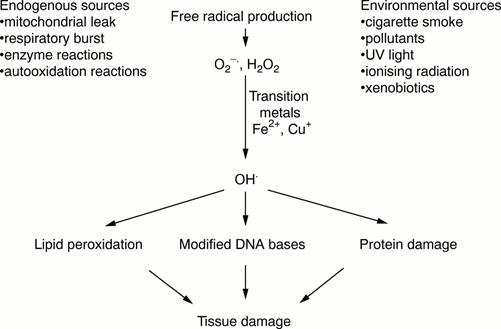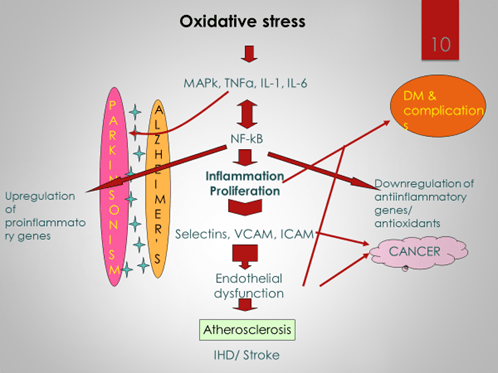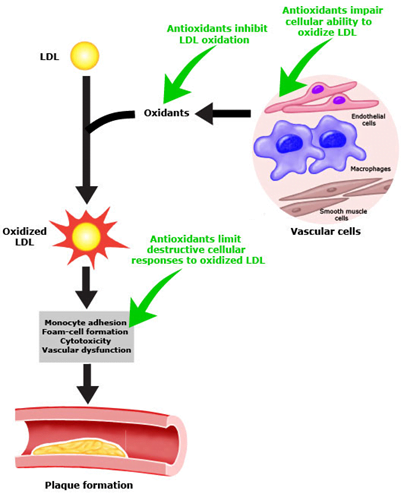Antioxidants
An antioxidant can be defined as a molecule that has the capability to inhibit the oxidation of another molecule and thereby reduces the free radical damage.


Sources and origin of antioxidants:
Antioxidants are abundant in fruits and vegetables, as well as in other foods including nuts, grains, and some meats, poultry, and fish.
Beta-carotene à foods that are orange in color, including sweet potatoes, carrots, apricots, pumpkin, and mangoes.
Some green, leafy vegetables, including collard greens, and spinach are also rich in betacarotene.
Lycopene àa potent antioxidant found in tomatoes, watermelon, guava, papaya, apricots, pink grapefruit, blood oranges, and other foods.
Estimates suggest 85% of American dietary intake of lycopene comes from tomatoes and tomato products.
Selenium is a mineral, not an antioxidant nutrient. However, it is a component of antioxidant enzymes. Plant foods like rice and wheat are the major dietary sources of selenium in most countries.
Vitamin A is found in three main forms: retinol (Vitamin A1), 3,4-didehydroretinol (Vitamin A2), and 3-hydroxyretinol (Vitamin A3).
Foods rich in vitamin A include liver, sweet potatoes, carrots, milk, egg yolks, and mozzarella cheese.
Vitamin C is also called ascorbic acid à fruits and vegetables and is also found in cereals, beef, poultry, and fish.
Classification:
Enzymatic Antioxidants:
Table 1:
| Common Enzymatic Antioxidants | Some Possible Specific Benefits or Problems | |
| Superoxide dismutase (SOD) | breakdown of superoxide anion, resulting in oxygen and hydrogen peroxide | Gene mutation encoding copper-zinc SOD associated with amyotrophic lateral sclerosis. |
| Catalase | breakdown of hydrogen peroxide to water and oxygen. | When infections arise, the body produces more hydrogen peroxide to help fight pathogens and heal wounds. Once the hydrogen peroxide is no longer needed, catalase breaks it down into safe compounds |
| Glutathione peroxidase (part of the glutathione system) | breakdown of hydrogen peroxide and various hydroperoxides. | The primary function of glutathione peroxidase is to counteract the oxidative attack |
Non-enzymatic Antioxidants:
- vitamin C which can only be obtained through the diet as it cannot be synthesized in humans
- Other non-enzymatic antioxidants include uric acid which accounts for almost one half the antioxidant capability of plasma, tocopherols which are known as vitamin E, melatonin, and glutathione.
Table 2:
| Common Antioxidant Dietary Supplements. | Some Possible Specific Benefits or Problems |
| Vitamin E Vitamin C (ascorbic acid) Selenium Zinc | vitamin E supplementation causes a reduction in heart disease risk. All three of the major dietary antioxidants — vitamin C, vitamin E, and carotenoids — have been associated with decreased cataract risk. |
| Carotenoids Beta carotene | High intake of beta carotene combined with vitamins C/E and zinc has been associated with decreased acute macular degeneration in the elderly. |
| Resveratrol | Associated with anti-inflammatory, anti-oxidant, and hypotriglyceridemic effects |
Clinical Significance of Antioxidants:
- Atherosclerosis and Cardiovascular Diseases:
Oxidation of low-density lipoprotein (LDL) à contribute to atherosclerosis.
Vitamin E has been shown to have scavenging activity at the cellular level. In Cambridge Heart Institute Study (CHAOS), a randomized control trial of vitamin E in patients with known coronary artery disease showed vitamin E reduced the rate of non-fatal MI in patients with coronary artery disease.

- Neurodegenerative Diseases:
such as amyotrophic lateral sclerosis, Huntington’s chorea, and Parkinson’s disease which seem to be increasing with an aging population.
Oxidative stress and free radicals play a significant role in the pathogenesis of neurodegenerative diseases.
Clinical trials with vitamins C, E, and beta carotene showed inconclusive results.
There is actually a proposed theory that free radicals are associated with aging and that lifespans might be extended by supplementation with antioxidants although research is needed to substantiate such a proposal.
- Selenium derivatives as cancer preventive agents:
The role of selenium in the prevention of cancer has been recently established by laboratory experiments, clinical trials, and epidemiological data.
Selenium supplementation has shown effective in the clinical domain of cancer chemoprevention and in the control of heart failure.
- Lycopene as a potential anti-cancer agent:
Tomato and products are recognized to confer a wide range of health benefits.
Epidemiology studies have provided evidence that high consumption of tomatoes effectively lowers the risk of reactive oxygen species (ROS)-mediated diseases such as cardiovascular diseases and cancer by improving the antioxidant carotenoid reported to be more stable and potent singlet oxygen quenching agent compared to other carotenoids.
In addition to its anti-oxidant properties, lycopene à cardioprotective, anti-inflammatory, anti-mutagenic and anti-carcinogenic activities. The cancer activities of lycopene have been demonstrated both in vitro and in vivo tumor models.
- Genetic disorder:
Antioxidants are very important in the treatment of Friedreich ataxia, a rare progressive condition that causes damage to the nervous system.
- Inflammatory disorders:
Free radicals and oxidative stress may play a role in inflammatory diseases.
Rheumatoid arthritis is one example.
The products of free radical reactions have been detected in the blood and joints of patients with this disease. Other lines of evidence also suggest the involvement of oxidative stress in rheumatoid arthritis and in other inflammatory diseases such as glomerulonephritis.
The use of antioxidants may useful in the prevention of these diseases.
The implication of oxidative stress in the aetiology of several chronic and degenerative diseases suggests that antioxidant therapy represents a promising avenue for treatment.
In the future, a therapeutic strategy to increase the antioxidant capacity of cells may be used to fortify the long-term effective treatment.
However, many questions about antioxidant supplements in disease prevention remain unsolved. Further research is needed before this supplementation could be officially recommended as adjuvant therapy.
In the meantime, it is reminded that avoiding oxidant sources (cigarettes, alcohol, bad food, stress, etc) must be considered as important as taking a diet rich in antioxidants. Indeed, our health also depends on our lifestyle choice.
